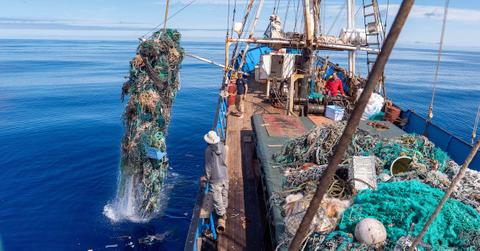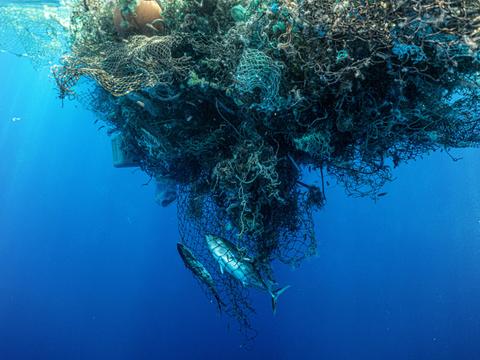An Ocean Cleanup Crew Just Collected a Record Amount of Ocean Plastic From the GPGP
Ocean Voyages Institute's crew just collected 103 tons of ocean plastic on a 48-day mission at sea.
Jul. 17 2020, Updated 11:08 a.m. ET

After 48 days at sea, the crew of a marine plastic recovery boat has successfully removed 103 tons (206,000 pounds) of plastic from the Great Pacific Garbage Patch. This is the area’s largest open ocean plastic cleanup on record, according to Ocean Voyages Institute, who operated the mission.
Ocean Voyages Institute is a nonprofit with a goal of preserving the oceans and teaching marine education. On May 4, the organization sent a crew out on the sailing cargo ship, S/V KWAI, after three weeks of quarantine to ensure no one had COVID-19. The crew then sailed to the world’s largest gyre of ocean plastic, the Great Pacific Garbage Patch, where an estimated 79 thousand tons of ocean plastic floats between Hawaii and California.


While at sea, the crew, led by Captain Brad Ives, used GPS satellite trackers to locate spots that were dense with discarded fishing nets. “We are utilizing proven nautical equipment to effectively clean-up the oceans while innovating with new technologies,” said Mary Crowley, founder and executive director of Ocean Voyages Institute, in a statement.
“We exceeded our goal of capturing 100 tons of toxic consumer plastics and derelict ‘ghost’ nets, and in these challenging times, we are continuing to help restore the health of our ocean, which influences our own health and the health of the planet,” Crowley added. “The oceans can’t wait for these nets and debris to break down into microplastics which impair the ocean’s ability to store carbon and toxify the fragile ocean food web.”
Nearly seven weeks after departing, the boat docked at the port of Honolulu on June 13, bearing the massive haul of ocean plastic. Matson, a Honolulu-based company, is helping Ocean Voyages Institute by sorting the 206,000 pounds of trash for upcycling and safe disposal.
The ocean plastic that the crew found primarily consisted of fishing nets. At least 46 percent of the ocean plastic in the Great Pacific Garbage Patch is made up of fishing nets, according to a March 2018 study published in Scientific Reports. Additionally, the UN estimates that the fishing industry dumps about 640,000 tonnes of fishing equipment into the ocean every year.
The GPGP is also filled with other fishing paraphernalia; consumer plastic, such as single-use straws, bottles, and Q-tips; and tiny pieces of plastic debris called microplastics, which are often the result of larger plastic items that have broken down into near-microscopic pieces.
When individuals and businesses look to reduce their contribution to ocean plastic, most people start by reducing the single-use plastic that they see, such as single-use plastic bags, cutlery, and coffee cups. While living a plastic-free lifestyle can certainly make a difference, we can’t ignore the fact that most ocean plastic comes from the commercial fishing industry. So if you’re looking to further reduce your contribution to the ocean plastic crisis, check out our guide to replacing the fish on your plate with vegan, fish-free seafood.


And the best part is, this is not the last you’ll be hearing of Ocean Voyages Institute. Captain Ives and the crew quickly turned around and set out on a sequel mission at the end of June, meaning they’ve been at sea for more than two weeks already. The Ocean Voyages Institute hopes to run many more of these voyages — if you’d like to support these efforts, you can donate on the nonprofit’s website.